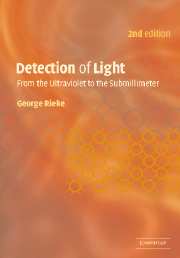Book contents
- Frontmatter
- Contents
- Preface
- 1 Introduction
- 2 Intrinsic photoconductors
- 3 Extrinsic photoconductors
- 4 Photodiodes and other junction-based detectors
- 5 Amplifiers and readouts
- 6 Arrays
- 7 Photoemissive detectors
- 8 Photography
- 9 Bolometers and other thermal detectors
- 10 Visible and infrared coherent receivers
- 11 Submillimeter- and millimeter-wave heterodyne receivers
- 12 Summary
- Appendices
- References
- Index
10 - Visible and infrared coherent receivers
Published online by Cambridge University Press: 09 November 2009
- Frontmatter
- Contents
- Preface
- 1 Introduction
- 2 Intrinsic photoconductors
- 3 Extrinsic photoconductors
- 4 Photodiodes and other junction-based detectors
- 5 Amplifiers and readouts
- 6 Arrays
- 7 Photoemissive detectors
- 8 Photography
- 9 Bolometers and other thermal detectors
- 10 Visible and infrared coherent receivers
- 11 Submillimeter- and millimeter-wave heterodyne receivers
- 12 Summary
- Appendices
- References
- Index
Summary
Coherent receivers are the third and last general category of detector listed in Section 1.2. These devices mix the electromagnetic field of the incoming photons with a local oscillating field to produce a signal at the difference, or beat, frequency. Unlike the output from the incoherent detectors discussed so far, this signal directly encodes the spectrum of the incoming signal over a range of input frequencies and also retains information about the phase of the incoming wavefront. As a result, these receivers are easily adapted for spectroscopy; in addition, their outputs can be combined to reconstruct the incoming wavefront, making interferometry between different receivers possible. A dramatic application of this latter capability is the use of intercontinental baseline radio interferometers to achieve milliarcsecond resolution in astronomy. Very weak signals can be detected in part because mixing the local field with the incoming photons allows the signal to be amplified in some situations. However, the main advantage of the technique is that the signals are downconverted to frequencies where extremely low noise electronics can be used to amplify them. Coherent receivers monopolize radio applications; they are not used as widely at infrared or optical frequencies because of their narrow spectral bandwidths, small fields of view, inability to be constructed in simple, large-format spatial arrays, and fundamental noise limitations that arise from the Heisenberg uncertainty principle (the “quantum limit”).
- Type
- Chapter
- Information
- Detection of LightFrom the Ultraviolet to the Submillimeter, pp. 275 - 301Publisher: Cambridge University PressPrint publication year: 2002



